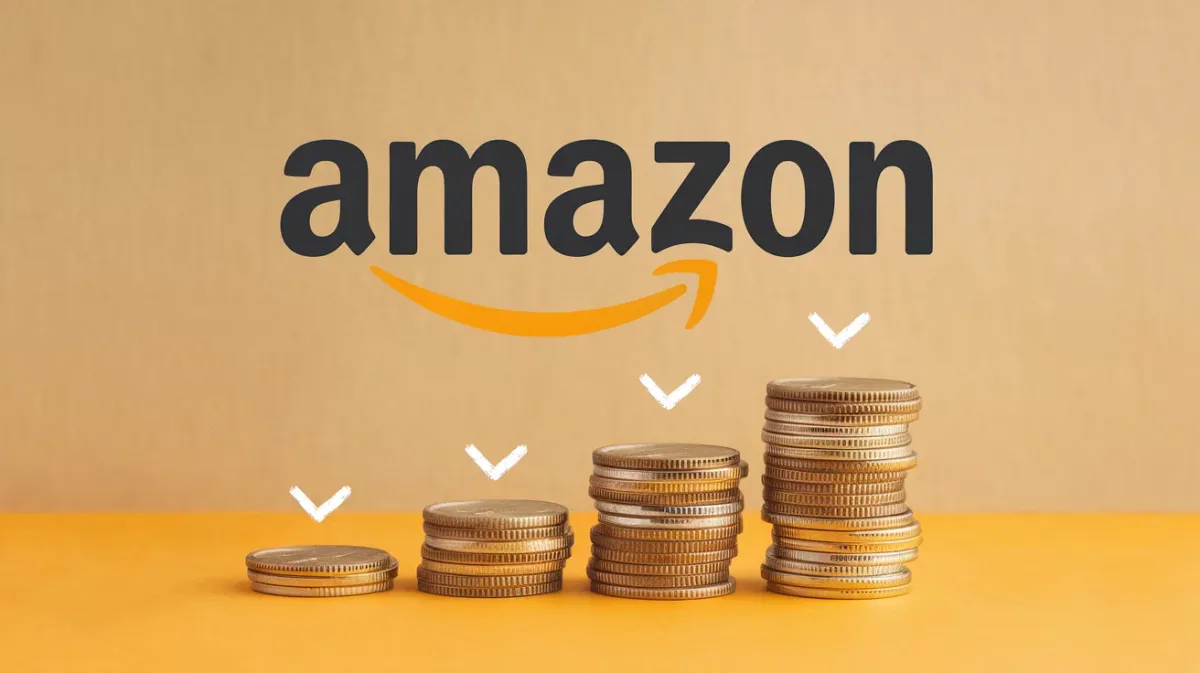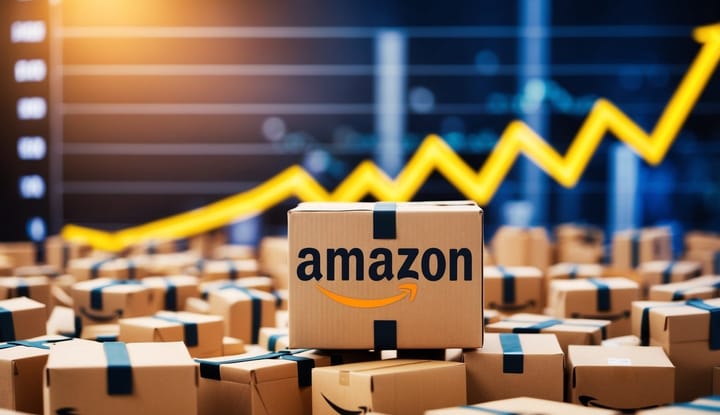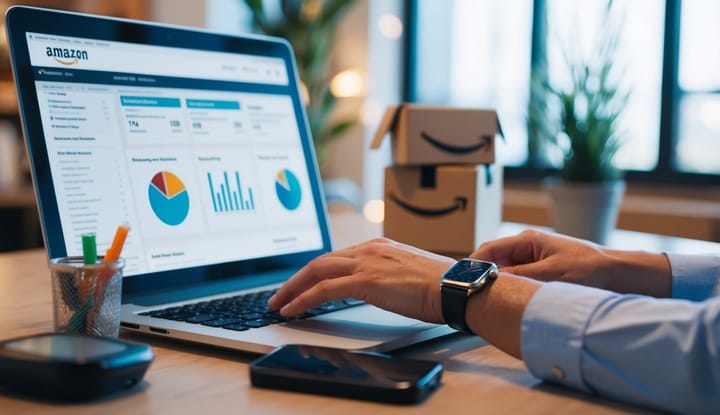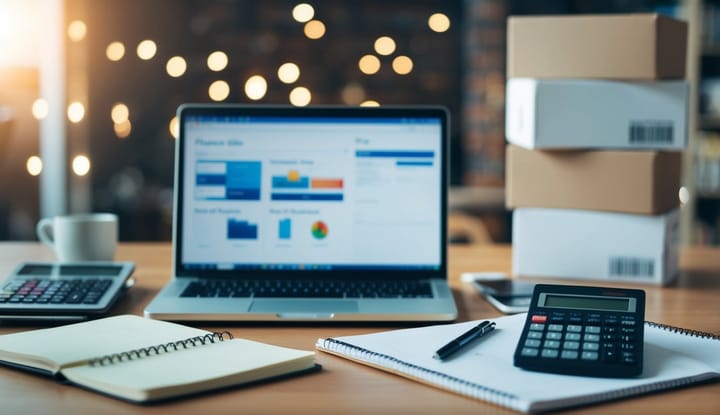Good Profit Margin for Amazon Sellers: Tips for Success

Do you dream of financial freedom through Amazon FBA? Many people want to be their own boss and make extra money. But what profit margin should you aim for to make your Amazon business profitable?
In 2024, the Amazon seller market is very competitive. With 57% of sellers making more than 10% profit and 28% making over 20%, success is possible. But what makes some sellers do better than others?
Let's explore Amazon FBA profit margins and find out how to increase your earnings. This is important for both new and experienced sellers. Knowing what affects your profits is key to doing well on Amazon.
Key Takeaways
- 57% of Amazon sellers achieve profit margins higher than 10%
- 28% of sellers see profit margins exceeding 20%
- Most sellers spend less than $5,000 to start their Amazon businesses
- 71% of sellers dedicate fewer than 20 hours per week to their Amazon ventures
- A recommended Gross Profit Margin is 30% or higher
- Aiming for a Return on Investment (ROI) of 100% or more is advised
- Successful sellers often transition from small budgets to seven-figure sales
Understanding Profit Margins on Amazon FBA
For Amazon FBA sellers, knowing about profit margins is key to doing well. Let's explore e-commerce profitability and see how to boost your profit margin as an Amazon product seller.
Defining Profit Margin
Profit margin is the part of revenue left after costs. For Amazon FBA sellers, it's the selling price minus all expenses. There are three main types:
- Gross profit margin: Revenue minus cost of goods sold
- Operating profit margin: Includes all operating expenses
- Net profit margin: Covers all costs, including taxes and interest
Why Profit Margins Matter
Profit margins are vital for Amazon FBA sellers. They show how well you're doing and help with pricing, sourcing, and growing your business.
Factors Affecting Profit Margins
Many things can change your profit margin on Amazon:
- Amazon fees: Referral fees (6-45% of sale price), FBA fees
- Product costs: Negotiating with suppliers can cut costs
- Pricing strategy: How you price affects sales
- Inventory management: Keeping stock in check saves money
- Marketing expenses: PPC campaigns affect profit
A good profit margin for an Amazon FBA seller is 15-20%. Less than 5% is risky. By improving these areas, you can increase your profits and succeed in e-commerce.
The Ideal Profit Margin for Amazon Sellers in 2024
In 2024, Amazon FBA businesses aim for profit margins between 15% and 25%. This range is a good balance for most sellers. Making more than 25% profit is great, but less than 8% could be risky.
A recent survey by Jungle Scout found most sellers are doing well. 57% of sellers make more than 10% profit, and 28% earn over 20%. This is good news for both new and experienced sellers.
To figure out your Amazon FBA profit, use this formula:
Profit Margin = [(Revenue - Total Cost) / Revenue] x 100
For example, if you sell a product for $50 and your total costs are $37, your profit margin is 26%. This is in the ideal range for Amazon sellers.
Many things affect your Amazon FBA profit, such as:
- Cost of Goods Sold (COGS)
- Amazon fees
- Advertising costs
- Returns and refunds
By improving these areas, you can increase your profit margins. New sellers often make about $30,000 a year, which is a good start for growth.
Calculating Your Amazon FBA Profit Margin
Knowing how to figure out your Amazon FBA profit margin is key to doing well on the platform. You need to look at different things that affect your profits.
Step-by-step Guide to Profit Margin Calculation
To find your Amazon profit margin, follow this formula:
Net Profit Margin = [(Total Revenue - Total Expenses) / Total Revenue] x 100%
Let's say you make $10,000 and spend $8,000. Your net profit margin is 20%. Don't forget to think about Amazon's fees, like:
- Referral fee: usually 15% for most items
- FBA fulfillment fees
- Long-term storage fees
- Extra charges like labeling and prep services
Tools for Accurate Calculations
There are tools to help you get your Amazon FBA profit margin right:
- Amazon Seller app
- Automate Pricing tool
- Product Opportunity Explorer
- FBA Revenue Calculator
The FBA Revenue Calculator is great for figuring out fees and profits. It's free and looks at fees like referral, fulfillment, and monthly storage costs. But, it doesn't cover long-term storage or return fees, so add those in yourself.
With these tools and knowing about fees, you can really understand your gross margin. This helps you make smart choices for your Amazon FBA business.
Amazon's Fee Structure and Its Impact on Profits
Understanding Amazon's fee structure is key for sellers wanting a high-profit margin. The system has many charges that can greatly affect your profits when selling on Amazon.
Amazon has two selling plans: Individual ($0.99 per item sold) and Professional ($39.99 monthly). The referral fees depend on the category, ranging from 3% to 45%. FBA sellers also face extra costs like storage and fulfillment fees.

Recent changes have made it harder to keep a good profit margin on Amazon. FBA fees went up by 20% for standard items and 28% for large items in 2021. A 5% fuel & inflation surcharge was added in 2023, making things even tougher.
To boost your profit margin, try these tips:
- Optimize product sizing to cut fulfillment costs
- Manage inventory levels to dodge aged inventory surcharges
- Use strategic promotions to avoid costly removals
Keep an eye on upcoming changes, like the Low-Inventory-Level Fee starting April 1, 2024, to keep profit margins up. By understanding and adjusting to Amazon's fees, sellers can aim for a profitable Amazon business.
| Fee Type | Cost Range | Impact on Profit |
|---|---|---|
| Selling Plan | $0.99 per item - $39.99 monthly | Fixed cost affecting overall margin |
| Referral Fees | 3% - 45% of item price | Varies by category, directly impacts profit |
| FBA Storage Fees | $0.69 - $0.94 per cubic foot | Increases with longer storage time |
| Removal Order Fees | $0.97 - $13.05 per unit | Affects inventory management costs |
Strategies to Increase Your Amazon Seller Profit Margins
Boosting your profit margins on Amazon needs a detailed plan. Let's look at key strategies to help you profit and increase your sales through Fulfillment by Amazon (FBA).
Optimizing Product Pricing
Setting the right prices is key to making a profit. Keep an eye on market trends and adjust your prices with the seasons. Use Amazon's tools to watch competitor prices and set smart pricing rules.
Improving Sourcing Operations
Find reliable suppliers for quality products at lower costs. Negotiate for bulk discounts and look for cheaper materials to cut costs. Good inventory management is key to knowing your profit margin.
Enhancing Product Listings
Write engaging product descriptions and use top-quality images to get more sales. Make your listings better with the right keywords to be more visible and drive sales.
Optimizing Advertising Campaigns
Use Amazon's ads to get your products seen more. Focus on specific keywords and keep an eye on how your ads do. Change your bids and target audience to get the best results from your ads.
Expanding into International Markets
Sell to customers worldwide through Amazon Global Selling. This can grow your sales and might increase your profit margins in different markets.
| Strategy | Potential Impact on Profit Margin |
|---|---|
| Optimizing Pricing | 5-10% increase |
| Improving Sourcing | 3-8% increase |
| Enhancing Listings | 2-5% increase |
| Optimizing Ads | 3-7% increase |
| International Expansion | 5-15% increase |
By using these strategies, you can aim for higher profit margins and long-term success on Amazon. Always check your performance and tweak your plan as needed.
Common Pitfalls Affecting Profit Margin on Amazon FBA
Selling on Amazon FBA can be profitable, but many sellers find it hard to keep a good profit margin. It's important to know the common mistakes to avoid. Let's look at some pitfalls that can hurt your profit margin as an Amazon seller.
Managing your inventory is key to keeping profit margins healthy. Overstocking means higher storage costs, while understocking means missing out on sales. A profit calculator can help you find the right balance.
Setting the right prices is another challenge. Prices that are too high or too low can cause Amazon to make mistakes, leading to lost sales. It's important to keep an eye on market trends and what your competitors are charging.
- Inaccurate product details
- Poor quality product photos
- Ineffective PPC advertising
- Neglecting customer service
These mistakes can result in more returns, bad reviews, and lower profit margins. Spending time on detailed listings, great photos, and smart PPC campaigns can really help you succeed on Amazon.
| Pitfall | Impact on Profit Margin | Solution |
|---|---|---|
| Inaccurate box dimensions | Higher FBA fees | Double-check measurements |
| Lost inventory | Reduced sales | Monitor shipment status |
| Non-GS1 UPC barcodes | Listing suppression | Use GS1-certified barcodes |
By avoiding these common mistakes and using tools like Eva for PPC, you can boost your profit margins. This will help you build a strong Amazon business. Remember, being profitable is what sets successful sellers apart in the Amazon market.
Benchmarking Your Profit Margins Against Industry Standards
Knowing how your product margin compares to others is crucial for both new and experienced sellers. Let's explore profit margins for products on Amazon and see where you stand.
Average Profit Margins by Category
Profit margins on Amazon change a lot depending on the product type. To get a clear picture, look at these usual ranges:
| Product Category | Average Net Profit Margin |
|---|---|
| Electronics | 15-18% |
| Home & Kitchen | 20-25% |
| Beauty & Personal Care | 18-22% |
| Clothing & Accessories | 17-20% |
Comparing Your Performance
To see how you're doing, check your margins against the best in the business. Many top Amazon sellers aim for a gross profit margin of 30% or more. High margins often mean more growth potential.
Profit margin is key for long-term success. Always check your margins to make smart choices on pricing and stock. By comparing to these standards, you can find ways to get better and set achievable goals for your Amazon business.
The Role of Data Analytics in Maximizing Profit Margins
Data analytics is key for Amazon sellers to boost profit margins. Tools like Sales Analytics by Jungle Scout help track sales, fees, and expenses in real-time. This gives sellers a clear view to enhance their Amazon performance and increase profits.
The AI Assist feature analyzes revenue, costs, and fees to provide detailed financial reports. These reports help sellers find ways to increase their Amazon profits. The Margin Widget shows the exact net profit and how much of the product price goes to profit.
Using data analytics effectively helps sellers:
- Optimize product pricing
- Improve sourcing operations
- Enhance product listings
- Fine-tune advertising campaigns
Sales Analytics lets sellers keep an eye on direct and indirect costs. This includes order fees, unit costs, PPC ads, and inventory expenses. Knowing how Amazon takes its cut helps sellers find ways to increase profits.
With these insights, sellers can make smart choices on pricing, managing inventory, and picking products. This strategy is crucial for doing well on Amazon and making more money in the competitive online market.
Future Trends Affecting Amazon Seller Profit Margins
Running a business on Amazon in 2024 means keeping up with new trends. These changes can affect how much profit you make. Let's look at what's shaping the future of selling on Amazon.
Emerging Technologies and Their Impact
AI and automation are changing online shopping. Sellers using these tools can make their work easier and more efficient. This could mean higher profits as costs go down. For example, smart inventory systems help keep the right amount of stock.
Shifts in Consumer Behavior
Customers want sustainable and personalized products more and more. This affects how sellers do business on Amazon. Changing to meet these needs might lower profits at first but could lead to success over time.
Changes in Amazon's Policies and Algorithms
Amazon often updates its rules and how it ranks sellers. These changes can really affect how visible you are and your sales. It's important to keep up and adapt quickly to keep a good profit margin.
| Trend | Impact on Profit Margin | Adaptation Strategy |
|---|---|---|
| AI Integration | Potential increase | Invest in AI tools for operations |
| Sustainable Products | Initial decrease, long-term increase | Develop eco-friendly product lines |
| Algorithm Changes | Varied | Regular SEO updates, monitor metrics |
Remember, profit margin is the part of revenue that turns into profit. Adjusting to these trends can help sellers make more profit on Amazon. Stay adaptable and keep learning to do well in the changing online shopping world.
Conclusion
Mastering profit margins is key for Amazon sellers wanting to succeed. A profit margin of 15% or more shows a seller is doing well on Amazon. To boost your profit and succeed long-term, learn how profit margin works and use smart strategies.
Sellers increase profit by optimizing prices, buying in bulk, and managing inventory well. The secret to more profit is choosing the right products, setting competitive prices, and using Amazon's tools effectively.
Having a sustainable business model is vital. A 10% profit margin is okay for some items, but aiming for 25-35% helps cover marketing costs and price changes. By always checking data, following market trends, and improving operations, sellers can overcome challenges and make the most of e-commerce.
Frequently Asked Questions
Q: What is considered a good profit margin for Amazon FBA sellers in 2024?
A: A good profit margin for Amazon FBA sellers in 2024 typically ranges from 20% to 40%. However, this can vary depending on the product category, competition, and sales volume. Some high-profit margin products may even reach 50% or more. It's important to note that a healthy profit margin should cover all costs, including Amazon fees, while still leaving room for profit.
Q: How do I calculate my Amazon profit margin?
A: To calculate your Amazon profit margin, use this formula: Profit Margin = (Revenue - Costs) / Revenue x 100. Include all costs such as product cost, shipping, Amazon fees, and any marketing expenses. For a more accurate calculation, consider using Amazon's profit calculator or specialized software designed for FBA sellers.
Q: What's the difference between gross profit margin and net profit margin for Amazon sellers?
A: Gross profit margin is the difference between the selling price and the cost of goods sold, while net profit margin takes into account all expenses, including Amazon fees, shipping, and overhead costs. Net profit margin gives a more accurate picture of your Amazon business's profitability and is essential for long-term success.
Q: How can I improve my profit margins as an Amazon FBA seller?
A: To improve your profit margins, consider these strategies: optimize your product pricing, reduce costs by negotiating with suppliers, improve your Amazon SEO to increase organic sales, use PPC advertising efficiently, focus on high-profit margin products, and constantly monitor and adjust your inventory levels. Additionally, consider bundling products or creating private label items to increase your profit potential.
Q: Are there specific product categories that tend to have higher profit margins on Amazon?
A: Yes, some product categories generally offer higher profit margins on Amazon. These include luxury items, unique or handmade products, niche electronics, and private label products. However, keep in mind that high-profit margin categories often come with increased competition. It's crucial to balance potential profits with market demand and your ability to differentiate your offerings.
Q: How do Amazon fees impact my overall profit margin?
A: Amazon fees can significantly impact your profit margin. These include referral fees (which vary by category), FBA fees, storage fees, and potential long-term storage fees. When calculating your profit margin, always factor in these costs. To maximize profitability, focus on products with a good balance between price point and Amazon fees, and manage your inventory efficiently to avoid excessive storage costs.
Q: What are some common mistakes that new Amazon sellers make when calculating profit margins?
A: Common mistakes include underestimating Amazon fees, forgetting to account for returns and damaged inventory, overlooking shipping costs to Amazon fulfillment centers, and not factoring in marketing expenses. Additionally, new sellers sometimes focus solely on gross profit margin without considering the net profit margin, which can lead to overestimating profitability. Always use a comprehensive approach when calculating your profit margins to ensure accuracy.
Q: How often should I review and adjust my profit margins as an Amazon seller?
A: As an Amazon seller, it's advisable to review your profit margins regularly, ideally on a monthly basis. However, during peak seasons or when there are significant market changes, more frequent reviews may be necessary. Continuously monitor your best-selling products and adjust prices or sourcing strategies as needed to maintain healthy profit margins. Remember, the Amazon marketplace is dynamic, and staying proactive is key to long-term success.
Ready to Start Growing Your Amazon Profits—Smarter?
Join our mini-course at WAH Academy and learn how to track your margins, reduce hidden fees, and build a lean, profitable Amazon FBA business—step by step.
No fluff. No guesswork. Just real strategies that actually work.
Tap the button and start boosting your FBA profits today.



